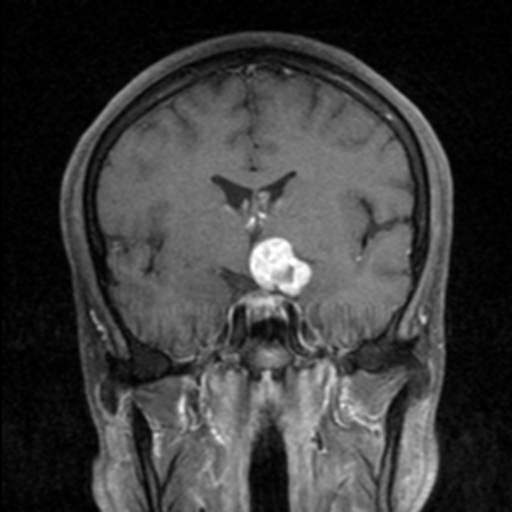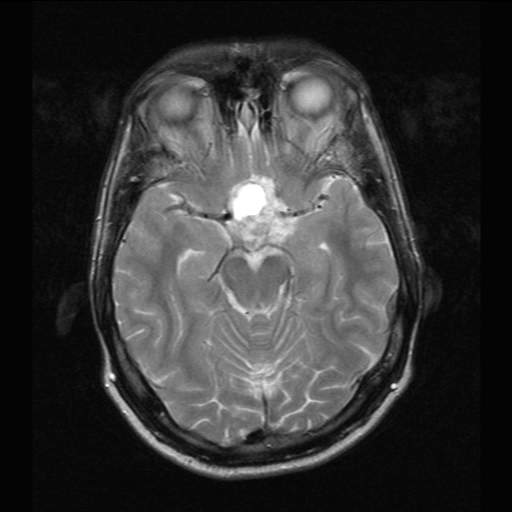Craniopharyngioma MRI: Difference between revisions
Marjan Khan (talk | contribs) No edit summary |
No edit summary |
||
| Line 1: | Line 1: | ||
__NOTOC__ | __NOTOC__ | ||
{{Craniopharyngioma}} | {{Craniopharyngioma}} | ||
{{CMG}}{{AE}}{{Marjan}} | {{CMG}}; {{AE}} {{Marjan}} | ||
==Overview== | ==Overview== | ||
The diagnostic evaluation of craniopharyngioma includes high-definition brain imaging. Brain MRI with and without contrast is the gold standard. Computed tomography (CT) scan is optional and may show some calcifications that can be seen in these tumors. However CT is not specific enough as a standalone diagnostic test. vascular imaging studies such as MR angiography (MRA) or CTA, is decided on a case-by-case basis typically for surgical planning or if a possible vascular malformation is spuspected. | The diagnostic evaluation of craniopharyngioma includes high-definition brain imaging. Brain MRI with and without contrast is the gold standard. Computed tomography (CT) scan is optional and may show some calcifications that can be seen in these tumors. However CT is not specific enough as a standalone diagnostic test. vascular imaging studies such as MR angiography (MRA) or CTA, is decided on a case-by-case basis typically for surgical planning or if a possible vascular malformation is spuspected. | ||
==MRI== | ==MRI== | ||
{| align="right" | |||
| | |||
[[File:Craniopharyngioma-t1corkm-001.jpg|thumb|200px|Coronal section of brain showing craniopharyngioma [https://upload.wikimedia.org/wikipedia/commons/c/c6/Craniopharyngioma-t1corkm-001.jpg Source:Wikimedia Commons] ]] | |||
|- | |||
| | |||
[[File:Craniopharyngioma-t2ax-003.jpg|thumb|200px|MRI showing transverse section of craniopharyngioma [https://upload.wikimedia.org/wikipedia/commons/e/e3/Craniopharyngioma-t2ax-003.jpg Source:Wikimedia Commons] ]] | |||
|- | |||
| | |||
[[File:Craniopharyngioma-t1corkm-003.jpg|thumb|200px|MRI showing cystic craniopharyngioma [https://upload.wikimedia.org/wikipedia/commons/e/ed/Craniopharyngioma-t1corkm-003.jpg Source:Wikimedia Commons] ]] | |||
|} | |||
The MRI findings depend on the type of craniopharyngioma.<ref>MRI findings of Craniopharyngioma. Dr Dylan Kurda and Dr Frank Gaillard et al. Radiopaedia 2015. http://radiopaedia.org/articles/craniopharyngioma</ref> | The MRI findings depend on the type of craniopharyngioma.<ref>MRI findings of Craniopharyngioma. Dr Dylan Kurda and Dr Frank Gaillard et al. Radiopaedia 2015. http://radiopaedia.org/articles/craniopharyngioma</ref> | ||
===Adamantinomatous=== | ===Adamantinomatous=== | ||
| Line 34: | Line 44: | ||
'''MR spectroscopy''': Cyst contents do not show a broad lipid spectrum as they are filled with water fluid. | '''MR spectroscopy''': Cyst contents do not show a broad lipid spectrum as they are filled with water fluid. | ||
<br><br><br><br><br> | |||
==References== | ==References== | ||
Revision as of 19:18, 13 February 2019
|
Craniopharyngioma Microchapters |
|
Diagnosis |
|---|
|
Treatment |
|
Case Studies |
|
Craniopharyngioma MRI On the Web |
|
American Roentgen Ray Society Images of Craniopharyngioma MRI |
Editor-In-Chief: C. Michael Gibson, M.S., M.D. [1]; Associate Editor(s)-in-Chief: Marjan Khan M.B.B.S.[2]
Overview
The diagnostic evaluation of craniopharyngioma includes high-definition brain imaging. Brain MRI with and without contrast is the gold standard. Computed tomography (CT) scan is optional and may show some calcifications that can be seen in these tumors. However CT is not specific enough as a standalone diagnostic test. vascular imaging studies such as MR angiography (MRA) or CTA, is decided on a case-by-case basis typically for surgical planning or if a possible vascular malformation is spuspected.
MRI
 |
 |
 |
The MRI findings depend on the type of craniopharyngioma.[1]
Adamantinomatous
Adamantinomatous type is the most common form (90%), and typically have a lobulated contour as a result of usually multiple cystic lesions. Solid components are present, but usually form a relatively minor component of the mass, and enhance vividly on MRI scans. The calcification is very common (90%). These tumor have a predilection to be large, extending superiorly into the third ventricle, and encasing vessels, and even being adherent to adjacent structures. The findings on MRI are:
- Cysts
- Variable but 80% are mostly or partly T2 hyperintense
- T1: iso- to hyperintense to brain (due to high protein content machinery oil cysts)
- Solid component
- T1 C+ (Gd): vivid enhancement
- T2: variable or mixed
- Calcification
- Difficult to appreciate on conventional imaging
- Susceptible sequences may better demonstrate calcification
MR angiography: It may demonstrate displacement of the A1 segment of the anterior cerebral artery (ACA).
MR spectroscopy: Cyst contents may show a broad lipid spectrum, with an otherwise flat baseline.
Papillary
Papillary craniopharyngioma tend to be more spherical in outline and usually lack the prominent cystic component; most are either solid or contain a few smaller cysts. Calcification is uncommon or even rare in the papillary subtype. These tumors tend to displace adjacent structures. The findings on MRI are:
- Cysts
- When present they are variable in signal
- 85% T1 hypointense
- Solid component
- T1: iso- to lightly hypointense to brain
- T1 C+: vivid enhancement
- T2: variable/mixed
MR spectroscopy: Cyst contents do not show a broad lipid spectrum as they are filled with water fluid.
References
- ↑ MRI findings of Craniopharyngioma. Dr Dylan Kurda and Dr Frank Gaillard et al. Radiopaedia 2015. http://radiopaedia.org/articles/craniopharyngioma